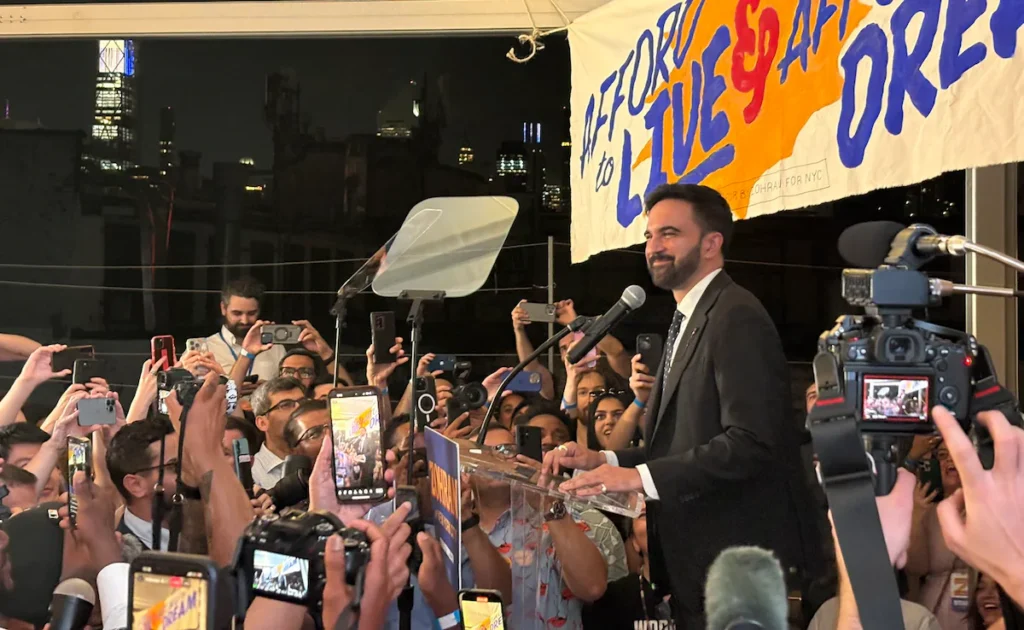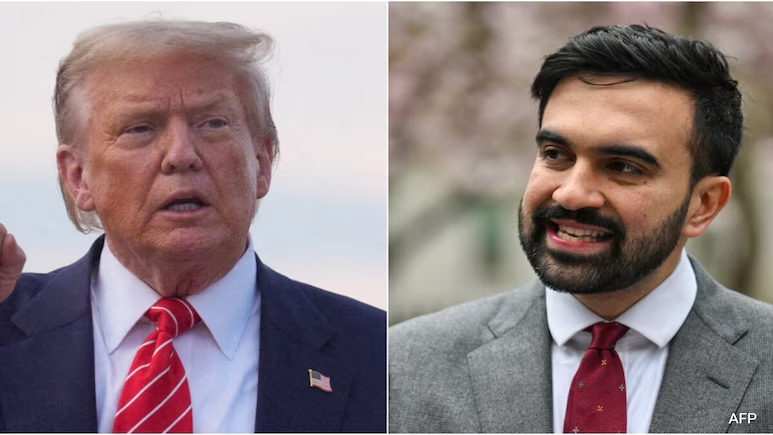
Donald Trump is back in the news for yet another controversial remark. This time, the former US President made a personal and insulting comment about a New York City Indian-origin mayor, saying, “He looks terrible.” The comment, although short and vague, has triggered widespread condemnation across the political spectrum, especially from the Indian-American community, which sees the remark as racially insensitive, disrespectful, and unbecoming of a former President.
During a campaign-style rally in New Jersey, Trump launched a broad attack on New York’s current governance and city leadership. In the middle of his speech, while discussing the supposed decline of American cities, he paused and suddenly commented on the appearance of a mayor of Indian origin, stating that “he looks terrible.” Though Trump did not take a specific name, his tone and choice of words have drawn criticism and concern from various political figures and social activists.
Who Is Mayor Trump Referred To?
Trump did not explicitly name the Indian-origin mayor, but speculations suggest that he could be referring to a key South Asian figure in New York City’s political landscape, possibly one of Mayor Eric Adams’ senior Indian-American deputies. While Trump’s ambiguity left room for interpretation, many believe this was a thinly veiled racial jab targeted toward the growing influence of Indian-origin public officials in American urban governance.
This isn’t the first time Donald Trump has been accused of racially tinged criticism. Over the years, he has mocked accents, questioned the loyalty of minority politicians, and made several derogatory remarks aimed at non-white leaders. For many, this latest comment is yet another entry in his long record of cultural insensitivity and divisive rhetoric.
Outrage from the Indian-American Community
The Indian-American community, which plays a significant and growing role in American politics, business, and society, reacted with fury and disappointment. Prominent leaders and netizens denounced the remark, calling it disrespectful, racially motivated, and unacceptable in modern democratic discourse. Many saw it as an attempt to undermine the dignity and credibility of Indian-origin officials, who are increasingly occupying high-profile positions in city and state administrations.
Congressman Raja Krishnamoorthi, a Democrat of Indian origin, did not mention Trump directly but issued a statement emphasizing the need for “respectful and constructive political dialogue, regardless of one’s background.” Similarly, Indian-American activists and scholars used social media to highlight how such language fosters alienation and fuels discrimination, especially at a time when the community is making strides toward mainstream inclusion.
A History of Offensive Remarks
It is important to note that Donald Trump has a history of making offensive or racially charged statements, especially against people of color. From calling immigrants criminals to mocking Muslim and Asian leaders, his comments have consistently drawn criticism and divided public opinion. His comment, “He looks terrible,” follows the same pattern—attacking the individual rather than the policy, focusing on physical appearance instead of governance or ideas.
Political commentators described this move as part of Trump’s “culture war strategy,” where he aims to provoke strong emotional reactions from both supporters and critics. According to them, these tactics are meant to dominate media coverage and shift the public debate away from policy failures or campaign weaknesses.
Indian-Americans in U.S. Politics: A Rising Force
The timing of Trump’s remark is especially notable as it coincides with the increasing visibility of Indian-Americans in U.S. politics. From Vice President Kamala Harris, whose mother was Indian, to governors, senators, and mayors of Indian origin, the community is now playing a central role in shaping policies at both state and national levels.
This rising influence, while celebrated, also makes Indian-origin officials more susceptible to criticism rooted in prejudice. The recent comment from Trump is seen as a reaction to this shifting political landscape, where diversity and inclusion are becoming core values of governance. His supporters may view such remarks as “straight talk,” but critics see it as a way to challenge and diminish the legitimacy of minority leaders.
Media Coverage and Public Backlash
The national and international media were quick to pick up the story. CNN, BBC, MSNBC, and The New York Times all covered the incident, calling attention to the racial implications of Trump’s comment. Editorials in leading newspapers questioned the appropriateness of mocking a mayor’s appearance, especially without any policy-related justification.
Social media, too, was flooded with reactions. Hashtags like #RespectOurLeaders, #SayNoToRacism, and #TrumpControversy began trending, as users from various backgrounds expressed solidarity with Indian-origin officials. Instagram reels, Twitter threads, and YouTube commentary videos dissected the incident and reminded audiences of Trump’s past behavior.
Even some Republican leaders showed discomfort with the remarks, although most chose not to comment directly. A few conservative commentators called for more issue-based campaigning and urged the former president to avoid personal attacks that damage the party’s image.
Official Response from the Mayor’s Office
In contrast to Trump’s tone, the response from the mayor’s office was professional and dignified. A spokesperson released a statement saying, “We are focused on building a better New York for all residents and do not wish to engage in personal or unproductive remarks.” This measured reaction was widely praised and seen as an example of mature leadership under pressure.
By choosing not to dignify the insult with an angry reply, the mayor demonstrated a calm, focused approach to leadership, further boosting his public image as someone who places governance over gimmicks.
Is This Racism in Disguise?
Experts have described Trump’s comment as “coded racism.” Instead of using an outright racial slur, he used a vague but harmful phrase like “He looks terrible,” which subtly targets a person’s ethnic identity and public image. Political analysts noted that this kind of language is common in dog-whistle politics, where the intent is to rally a particular base without making explicit racist statements.
Dr. Meera Bhattacharya, a professor of Political Sociology at Columbia University, explained, “Trump knows what he’s doing. When he mocks a minority leader, it sends a signal to those who feel threatened by diversity.” Such language may seem minor on the surface but contributes to a larger culture of division, xenophobia, and intolerance.
In today’s world, where diversity, inclusion, and mutual respect are key to strong leadership, comments like “He looks terrible” are not just offensive—they are damaging to democracy itself. They hurt not just the individual being targeted, but also the millions who identify with them, work hard to break barriers, and serve the nation with integrity.
Donald Trump’s remark may be brief, but its consequences are far-reaching. It has once again exposed the deep racial fault lines that still exist in American politics. It also reminds us why representation matters, and why we must defend dignity over division.
The Indian-American mayor, despite being the subject of insult, has stood tall and focused on serving the public. His grace under pressure has become a symbol of how leadership should be practiced in the face of provocation. Meanwhile, Trump’s words have reopened a necessary conversation on how political leaders should talk about each other, and the urgent need for respectful public discourse in a divided world.































